
ColecoVision is a second-generation home video-game console developed by Coleco and launched in North America in August 1982. It was released a year later in Europe by CBS Electronics as the CBS ColecoVision.

Pac-Man, originally called Puck Man in Japan, is a 1980 maze action video game developed and released by Namco for arcades. In North America, the game was released by Midway Manufacturing as part of its licensing agreement with Namco America. The player controls Pac-Man, who must eat all the dots inside an enclosed maze while avoiding four colored ghosts. Eating large flashing dots called "Power Pellets" causes the ghosts to temporarily turn blue, allowing Pac-Man to eat them for bonus points.

Millipede is a fixed shooter video game released in arcades by Atari, Inc. in 1982. The sequel to 1981's Centipede, it has more gameplay variety and a wider array of insects than the original. The objective is to score as many points as possible by destroying all segments of the millipede as it moves toward the bottom of the screen, as well as eliminating or avoiding other enemies. The game is played with a trackball and a single fire button which can be held down for rapid-fire.

Centipede is a 1981 fixed shooter arcade video game developed and published by Atari, Inc. Designed by Dona Bailey and Ed Logg, it was one of the most commercially successful games from the golden age of arcade video games and one of the first with a significant female player base. The primary objective is to shoot all the segments of a centipede that winds down the playing field. An arcade sequel, Millipede, followed in 1982.
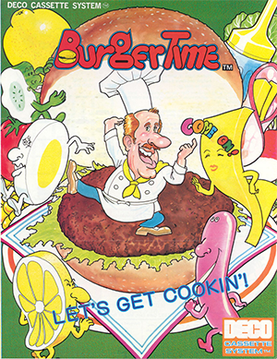
BurgerTime, originally released as Hamburger in Japan, is a 1982 arcade video game developed by Data East, initially for its DECO Cassette System. The player is chef Peter Pepper, who must walk over hamburger ingredients in a maze of platforms and ladders while avoiding anthropomorphic hot dogs, fried eggs, and pickles which are in pursuit.

Ms. Pac-Man is a 1982 maze arcade video game developed by General Computer Corporation and published by Midway. It is the first sequel to Pac-Man (1980) and the first entry in the series to not be made by Namco. Controlling the title character, Pac-Man's wife, the player is tasked with eating all of the pellets in an enclosed maze while avoiding four colored ghosts. Eating the larger "power pellets" lets the player eat the ghosts, who turn blue and flee.

Mouse Trap is a maze video game developed by Exidy and released in arcades in 1981. It is similar to Pac-Man, with the main character replaced by a mouse, the dots with cheese, the ghosts with cats, and the energizers with bones. After collecting a bone, pressing a button turns the mouse into a dog for a brief period of time. Color-coded doors in the maze can be toggled by pressing a button of the same color. A hawk periodically flies across the maze, unrestricted by walls.
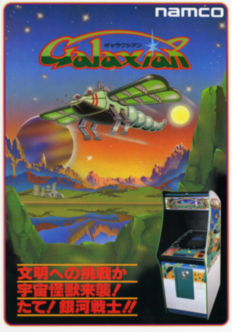
Galaxian is a 1979 fixed shooter arcade video game developed and published by Namco. The player assumes control of the Galaxip starfighter in its mission to protect Earth from waves of aliens. Gameplay involves destroying each formation of aliens, who dive down towards the player in an attempt to hit them.
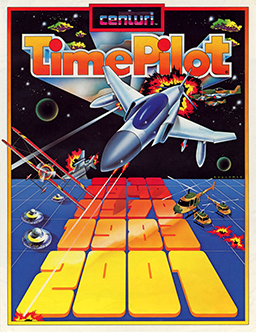
Time Pilot is a multidirectional shooter arcade video game designed by Yoshiki Okamoto and released by Konami in 1982. It was distributed in the United States by Centuri, and by Atari Ireland in Europe and the Middle East. While engaging in aerial combat, the player-controlled jet flies across open airspace that scrolls indefinitely in all directions. Each level is themed to a different time period. Home ports for the Atari 2600, MSX, and ColecoVision were released in 1983.
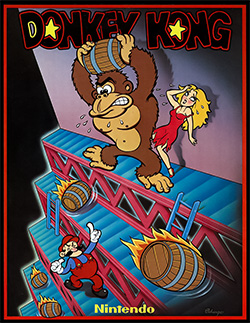
Donkey Kong is a 1981 arcade video game developed and published by Nintendo. As Jumpman, the player runs and jumps on platforms and climbs ladders to ascend a construction site and rescue Pauline from a giant gorilla named Donkey Kong. It is the first game in the Donkey Kong series as well as Mario's first appearance in a video game.
1982 was the peak year for the golden age of arcade video games as well as the second generation of video game consoles. Many games were released that would spawn franchises, or at least sequels, including Dig Dug, Pole Position, Mr. Do!, Zaxxon, Q*bert, Time Pilot and Pitfall! The year's highest-grossing video game was Namco's arcade game Pac-Man, for the third year in a row, while the year's best-selling home system was the Atari 2600. Additional video game consoles added to a crowded market, notably the ColecoVision and Atari 5200. Troubles at Atari late in the year triggered the video game crash of 1983.

Mr. Do! is a 1982 maze game developed by Universal. It is the first arcade video game to be released as a conversion kit for other arcade machines; Taito published the conversion kit in Japan. The game was inspired by Namco's Dig Dug released earlier in 1982. Mr. Do! was a commercial success in Japan and North America, selling 30,000 arcade units in the US, and it was followed by several arcade sequels.

Bump 'n' Jump is an overhead-view vehicular combat game developed by Data East and originally released in Japan as Burnin' Rubber. Distributed in North America by Bally Midway, the arcade version was available as both a dedicated board and as part of Data East's DECO Cassette System. The goal is to drive to the end of a course while knocking enemy vehicles into the sides of the track and jumping over large obstacles such as bodies of water.

Smurf: Rescue in Gargamel's Castle is a 1982 video game published and developed by Coleco for the ColecoVision and Atari 2600. The game is based on the television series The Smurfs. In the game, the player must brave a series of obstacles to rescue Smurfette from Gargamel's castle.

Space Panic is a 1980 arcade video game developed by Universal. Predating Nintendo's Donkey Kong, and lacking a jump mechanic, Space Panic was the first game involving climbing ladders between walkable platforms. The genre was initially labeled "climbing games," but later became known as platform games. A ColecoVision port by CBS Electronics was released in the winter holiday season of 1982.

Lock 'n' Chase (ロック・ン・チェイス) is a maze chase video game developed by Data East and released in arcades in Japan in 1981. It was licensed to Taito for distribution in North America. Lock 'n' Chase has similarities to Pac-Man, including a goal of collecting dots, with the addition of doors that periodically block pathways. Home versions for the Intellivision and Atari 2600 were published by Mattel in 1982 and an Apple II version in January 1983.

Tutankham is a 1982 arcade video game developed and released by Konami and released by Stern in North America. Named after the Egyptian pharaoh Tutankhamun, the game combines a maze shoot 'em up with light puzzle-solving elements. It debuted at the European ATE and IMA amusement shows in January 1982, before releasing worldwide in Summer 1982. The game was a critical and commercial success and was ported to home systems by Parker Brothers.
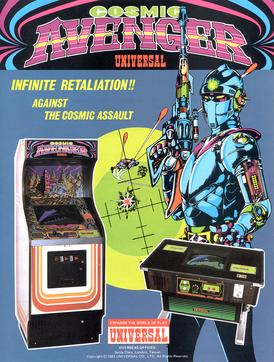
Cosmic Avenger is a horizontally scrolling shooter developed by Universal Entertainment Corporation and released in arcades by Universal in July 1981. It is one of the first shooters with forced horizontal scrolling along with Konami's Scramble released earlier in the year. The final installment in Universal's Cosmic series, players take control of the Avenger space fighter and use bullets and bombs against enemy forces.

Pepper II is an arcade video game developed by Exidy and published in 1982. Despite its name, there was no predecessor named Pepper or Pepper I. As in Amidar by Konami and Stern Electronics, the goal is to color the lines on a grid; each rectangle is filled-in after being completely surrounded. Coleco published a port of Pepper II for its ColecoVision home system.

Looping is an action game developed and published in arcades in 1982 by Video Games GmbH in Europe and Venture Line in North America. The player controls a plane across two phases in order to reach a docking station by destroying a terminal base or a rocket base to open a gate while avoiding obstacles along the way.




















